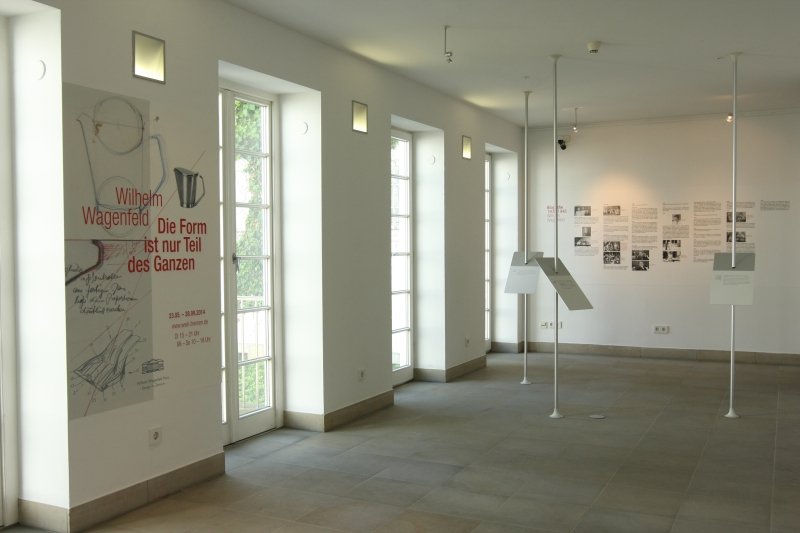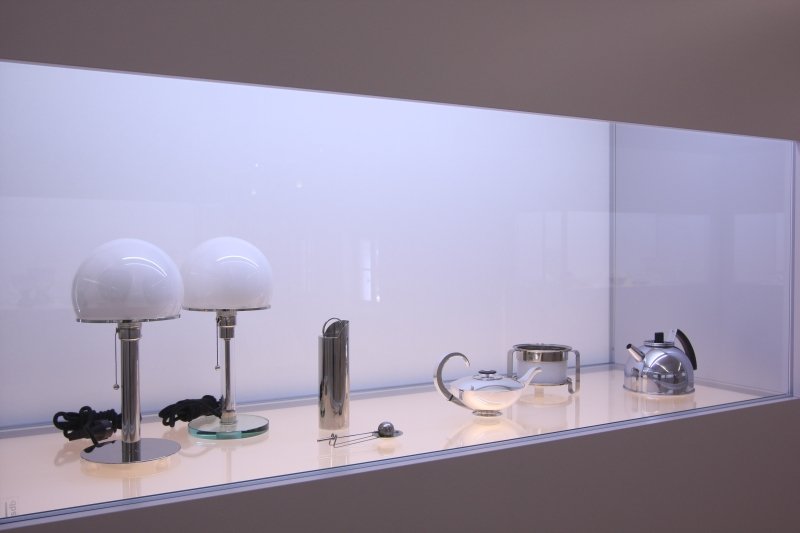"The purpose of an object is of secondary importance" claimed the German designer and artist Wilhelm Wagenfeld, "the use however is more relevant, explains the multi-faceted relationship of individuals to those objects which surround them. With use develops culture, the overcoming of a perceived raison d'etre"
To celebrate their 20th anniversary the Bremen based Wilhelm Wagenfeld Foundation are currently hosting "Die Form ist nur Teil des Ganzen" - "The Form is Only a Part of the Composition" - an exhibition which not only explains how Wilhelm Wagenfeld dealt with the challenge of making "usable" objects but which much more helps explain that it is because Wilhelm Wagenfeld so adeptly rose to this challenge that his work, or at least a sizeable proportion of it, remains today as accessible and contemporary as it was then.

Born in Bremen on April 15th 1900 Wilhelm Wagenfeld initially apprenticed as a technical drawer with Bremen based silversmiths Koch & Bergfeld before training as a silversmith in Hanau. In 1923 Wilhelm Wagenfeld joined the metal workshop at Bauhaus Weimar and subsequently moved with the institute to Dessau where in 1926 he was appointed assistant before in 1928 taking command of the metal workshop. In 1930 Wagenfeld left Bauhaus and began working for a range of industrial companies as a freelance designer and consultant, most notably Jenaer Glaswerk Schott, Rosenthal and the Vereinigten Lausitzer Glaswerke in Weißwasser, a company whose creative department he led during the War years. Post World War II Wagenfeld relocated to Stuttgart where alongside cooperations with the likes of WMF and Lindner he established his own experimental workshop, "Werkstatt Wagenfeld." In addition to his design work Wilhelm Wagenfeld was a prolific author, co-founded the German design magazine Form, was an active and vocal member of the Deutscher Werkbund and taught at the Hochschule für die bildenden Künste Berlin. Wilhelm Wagenfeld died in Stuttgart on May 28th 1990.
With "The Form is Only a Part of the Composition" the Wilhelm Wagenfeld Foundation, under the leadership of Foundation Director Beate Manske, aim to provide a new impression of Wilhelm Wagenfeld, to throw new light on the man and his work, "Until now we have only presented exhibitions which allowed an overview of Wilhelm Wagenfeld's oeuvre,", explains Frau Manske, "but what they didn't offer was a deeper insight into why Wagenfeld did what he did, how he thought and so ultimately why he became Germany's most successful industrial designer"
To this end the Foundation are presenting Wilhelm Wagenfeld's canon in context of five thematic sections, "Use", "Changing Tastes and Form Giving", "The Wagenfeld Workshop", "Collaboration in Factories" and "Technical Innovation", each section being illustrated by relevant examples of Wagenfeld's work, original sketches, prototypes and presentations of the various development and/or production stages of products and product types. A final section presents a briefest of brief overviews of Wilhelm Wagenfeld's oeuvre including objects created during his days at Bauhaus and examples of his commercial projects for and with some of his most important clients, including Vereinigten Lausitzer Glaswerke, WMF, Rosenthal and Jenaer Glaswerk Schott.
In addition to the well known Wilhelm Wagenfeld classics such as his Bauhaus Lamp, Jenaer Glass teapot or the "Kubus-Geschirr" storage system, the exhibition presents a range of articles often as banal as they are fascinating, including a punch bowl that in a wonderful parallel development to his glass teapot has a central glass "void" into which ice can be placed to chill the punch. That ice and punch are separated the inevitably melting ice can't water down the punch. And once the ice has melted it can simply be replaced with fresh. Genius. Further exhibits include, for example, ink bottles, an apple grater, a mustard jar with integrated spoon and no end of butter dishes. As we say, banal but fascinating.
One of the most intriguing objects in the exhibition is "Combi" a combination record player/radio Wilhelm Wagenfeld designed for Braun in 1955. According to a quote in the exhibition from Erwin Braun Combi represented his and his brother Artur Braun's "first lesson in industrial design." In 1956 Braun launched the now classic, if not iconic, SK4 record player/radio by Hans Gugelot and Dieter Rams. Had the Braun's decided to stay with their "first lesson", and Wagenfeld's design, the history of post-war German design could/would have been very different. As would the physical appearance of your iPad.

What immediately catches your attention in the exhibition is the famous, almost clichéd, unremarkableness of the majority of Wagenfeld's output. The secret to achieving this mundaneness is the care and attention with which Wagenfeld created his products; not just in terms of crafting them but in observing how people used objects and in considering how future use would vary compared to contemporary use. A care and attention that means you don't notice the object because it is so natural. Obvious. For Wilhelm Wagenfeld considerations on achieving this unremarkableness were always a starting point of his design process and guided his understanding of his responsibility throughout his career.
The Form is Only a Part of the Composition makes that very clear.
What the exhibition doesn't do so well is look at the person behind the designer, explore in depth what drove Wilhelm Wagenfeld. Which we would class as important in an exhibition looking to get to the "inner core". Yes some aspects are briefly touched upon, but the person Wilhelm Wagenfeld remains hidden behind the designer Wilhelm Wagenfeld, or perhaps better put the artist Wilhelm Wagenfeld. Yet ultimately one can't place one before the other, the one influenced the other. And lest we forget Wilhelm Wagenfeld was active through some exciting, turbulent and important periods of European political, cultural and social history. It would be good to know how these affected his work.
What the exhibition also doesn't do is inspire. At least not initially.
In short the exhibition presents objects in glass display cabinets illuminated by LED spotlights and all staged in white emulsioned rooms. A display concept that of course deprives the objects of the "use" Wagenfeld so diligently gave them, and which gives the impression that the form is indeed more than just a part of the composition. But then to be fair, presenting a collection largely composed of glass and ceramic is always going to present curatorial challenges.
In addition one must add, and with the best will in the world, the Wilhelm Wagenfeld House isn't especially suitable as a museum. The space is too sterile, too airless, the room division and inner architecture being such that you always have the feeling you are in a corridor. Never that you are in a space where you are expected to linger for longer than absolutely necessary.
But don't be put off by the dry presentation format. Please. The Form is Only a Part of the Composition is a well conceived and thought through exhibition that very nicely highlights and explains key aspects of Wilhelm Wagenfeld's approach to his work without overburdening the visitor, and which serves as a nice guide as to how to design products that maintain their charm, their allure and for all their use for generations to come.
Wilhelm Wagenfeld: Die Form ist nur Teil des Ganzen can be viewed until Sunday September 28th at the Wilhelm Wagenfeld Haus, Am Wall 209, 28195 Bremen.
Full details, including opening times and ticket prices, though sadly only in German, can be found at www.wwh-bremen.de